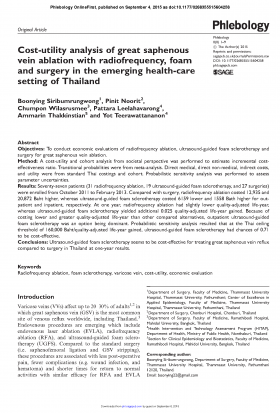This website uses cookies so that we can provide you with the best user experience possible. Cookie information is stored in your browser and performs functions such as recognising you when you return to our website and helping our team to understand which sections of the website you find most interesting and useful.
Cost-utility analysis of great saphenous vein ablation with radiofrequency, foam and surgery in the emerging health-care setting of Thailand (2015)

รายละเอียดเพิ่มเติม
Boonying Siribumrungwong1, Pinit Noorit2,
Chumpon Wilasrusmee3, Pattara Leelahavarong4,
Ammarin Thakkinstian5 and Yot Teerawattananon4
Abstract
Objectives: To conduct economic evaluations of radiofrequency ablation, ultrasound-guided foam sclerotherapy and surgery for great saphenous vein ablation.
Method: A cost-utility and cohort analysis from societal perspective was performed to estimate incremental costeffectiveness ratio. Transitional probabilities were from meta-analysis. Direct medical, direct non-medical, indirect costs,
and utility were from standard Thai costings and cohort. Probabilistic sensitivity analysis was performed to assess parameter uncertainties.
Results: Seventy-seven patients (31 radiofrequency ablation, 19 ultrasound-guided foam sclerotherapy, and 27 surgeries) were enrolled from October 2011 to February 2013. Compared with surgery, radiofrequency ablation costed 12,935 and
20,872 Baht higher, whereas ultrasound-guided foam sclerotherapy costed 6159 lower and 1558 Bath higher for outpatient and inpatient, respectively. At one year, radiofrequency ablation had slightly lower quality-adjusted life-year,
whereas ultrasound-guided foam sclerotherapy yielded additional 0.025 quality-adjusted life-year gained. Because of costing lower and greater quality-adjusted life-year than other compared alternatives, outpatient ultrasound-guided
foam sclerotherapy was an option being dominant. Probabilistic sensitivity analysis resulted that at the Thai ceiling threshold of 160,000 Baht/quality-adjusted life-year gained, ultrasound-guided foam sclerotherapy had chances of 0.71
to be cost-effective.
Conclusions: Ultrasound-guided foam sclerotherapy seems to be cost-effective for treating great saphenous vein reflux compared to surgery in Thailand at one-year results.
Full text can be accessed from: http://phl.sagepub.com/content/early/2015/09/04/0268355515604258.abstract




